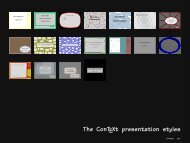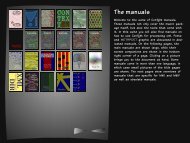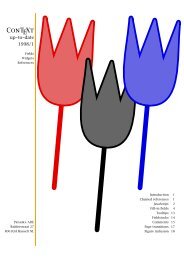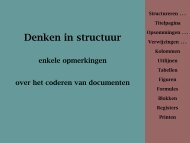What is ConTeXt - Pragma ADE
What is ConTeXt - Pragma ADE
What is ConTeXt - Pragma ADE
Create successful ePaper yourself
Turn your PDF publications into a flip-book with our unique Google optimized e-Paper software.
context
1<br />
Rationale<br />
Occasionally I run into a description of ConT E Xt that contains observations<br />
that are somewhat off. It therefore makes sense to provide some insight in<br />
why th<strong>is</strong> macro package looks the way it looks. <strong>What</strong> started out as a T E X<br />
only system evolved via adding METAPOST to the current hybrid system that<br />
also uses and provides Lua. However, the original goals and principles are<br />
still valid.<br />
The system<br />
The T E X macro language and interpreter are about automated typesetting.<br />
A collection of predefined macros <strong>is</strong> called a macro package and ConT E Xt<br />
<strong>is</strong> such a package. The program that interprets the macros and converts<br />
input into typeset results <strong>is</strong> called the engine. An example of an engine <strong>is</strong><br />
LuaT E X. The graphic companion of T E X <strong>is</strong> METAFONT, or nowadays METAPOST<br />
and ConT E Xt integrates support for that graphical language and rendering.<br />
As ConT E Xt comes with a bunch of tools that manage the process it <strong>is</strong> a<br />
sort of typographic ecosystem. The input can be a document encoded in<br />
structured T E X code or it can be xml. In fact anything that makes sense<br />
can be processed if only because we can use Lua to convert it runtime. The<br />
output <strong>is</strong> in most cases pdf, but xml (or xhtml with CSS) <strong>is</strong> also an option. In<br />
addition to static printable documents you can produce highly interactive<br />
documents for screen and reader.<br />
The T E X system, and therefore ConT E Xt, are quite capable to produce high<br />
quality output, can handle many scripts and languages, are able to typeset<br />
mathematics and can keep up pretty well with developments, thanks to the<br />
open character of the whole system. There <strong>is</strong> an active community that<br />
takes care of the software d<strong>is</strong>tributions and develops the engines as well as<br />
additional resources like fonts. User groups play an important role in th<strong>is</strong>.<br />
The ConT E Xt system <strong>is</strong> supported by active mailing l<strong>is</strong>ts and a wiki.<br />
The syntax<br />
The syntax <strong>is</strong> rather straightforward and uses commands that start with a \,<br />
the curly braces {} for delimiting variable content and the square brackets
2<br />
[] for (optional) directives and settings. A good example <strong>is</strong> one of the oldest<br />
commands:<br />
\startitemize[packed]<br />
\item some text<br />
\item some more text<br />
\stopitemize<br />
Before we ran into T E X we already had some programs that dealt with simple<br />
formatting and start/stop constructs were used there. The not delimited<br />
\item command was just taken from what we saw in other T E X code. In retrospect<br />
we should have used \startitem and \stopitem commands right<br />
from the start but it’s only with MkIV that we start promoting th<strong>is</strong> more<br />
strongly. Actually there are only a few commands that are not delimited<br />
and th<strong>is</strong> <strong>is</strong> one of them. So, th<strong>is</strong> <strong>is</strong> today’s fashion:<br />
\startitemize[packed]<br />
\startitem some text \stopitem<br />
\startitem some more text \stopitem<br />
\stopitemize<br />
One reason for getting rid of the few non delimited cases <strong>is</strong> that <strong>is</strong>’t more<br />
cleaner in the perspective of hooking in code as well as exporting to for<br />
instance xml.<br />
The (optional) argument between square brackets use those brackets because<br />
for a beginning macro writer (which I definitely was when I started<br />
with ConT E Xt) it’s not that hard to implement. It also looks nice on screen,<br />
especially when you use syntax highlighting. When ConT E Xt showed up we<br />
still used our own editor and it used a color scheme that can still be found<br />
in the pretty printer code. So, to a large extent, the syntax has been determined<br />
by how well it could be v<strong>is</strong>ualized in an editor. We set up commands<br />
using:<br />
\setupsomething<br />
[whatever]<br />
[key-1=value-1,<br />
key-2=value-2]
3<br />
Spaces after a comma are ignored contrary to spaces before and after an<br />
equal sign. It takes more (and slower) code to do that and picking up keys<br />
and values <strong>is</strong> already slow enough, especially when we started doing it.<br />
I’m writing th<strong>is</strong> in the SciTE editor (2.29) using updated syntax highlighting<br />
code that was added to the d<strong>is</strong>tribution around the ConT E Xt conference in<br />
2011. Of course the T E X code gets highlighted, but so does METAPOST and<br />
Lua code. Runtime spell checking <strong>is</strong> included. Developments like that have<br />
some impact on the user interface and the way (low level) code <strong>is</strong> written.<br />
V<strong>is</strong>ualization of code and source has been and always will be an important<br />
aspect of how ConT E Xt evolves.<br />
The multilingual interface<br />
A second important aspect of ConT E Xt <strong>is</strong> that there <strong>is</strong> just one version. I<br />
simply could not come up with a good reason to use different names for<br />
different engines. After all, most of the (older) core functionality <strong>is</strong> shared.<br />
It <strong>is</strong> always a surpr<strong>is</strong>e to run into descriptions of ConT E Xt being dependent<br />
on pdfT E X, Perl, or Ruby. In ConT E Xt there has always been an abstract layer<br />
between the core code and the backend and support and in MkII relatively<br />
little amount of backend specific code <strong>is</strong> loaded. In MkIV we have several<br />
backends running at the same time: pdf and xml export can run in parallel.<br />
Being closely involved in the development of pdfT E X naturally means that<br />
I used that engine but originally we used dvipsone and ConT E Xt MkII supports<br />
several backends. The dependency on Perl and later Ruby was only<br />
true for the script that manages a run (originally the index sorter was written<br />
in Modula2). One could run unmanaged but it’s much more convenient<br />
for users not to worry about how many runs are needed. It also gave us<br />
the opportunity to provide command line arguments. And of course index<br />
sorting has to happen somewhere out of T E X itself so why not combine these<br />
tasks in one script. When we moved on to Lua it was natural to stick to only<br />
Lua and as LuaT E X <strong>is</strong> also a Lua interpreter, there <strong>is</strong> no extra dependency<br />
in ConT E Xt MkIV.<br />
We have only one version, but on your system you might find more than one<br />
cont-* file. The reason for th<strong>is</strong> <strong>is</strong> that there are different user interfaces.<br />
We started with the Dutch interface and later added an Engl<strong>is</strong>h and German<br />
one. Of course some more followed.
4<br />
When we started using LuaT E X, it quickly became clear that we had to split<br />
the code base and so we did. In fact one can now indeed claim a dependency:<br />
on LuaT E X. The fact that MkII <strong>is</strong> frozen <strong>is</strong> a clear signal that we see<br />
no future for the other engines in the ConT E Xt community and their development<br />
<strong>is</strong> stalled anyway. The same <strong>is</strong> true for related technologies like fonts.<br />
Why stick to obsolete font formats when we can move on. Fortunately users<br />
are quite willing to move on with us.<br />
The dependency on Lua <strong>is</strong> not so much a dependency as well as progress,<br />
especially if we keep in mind that the development of LuaT E X has been<br />
driven by the ConT E Xt people. It’s way more fun to use the T E X, Lua and<br />
METAPOST languages for what they are best suited for than to try to squeeze<br />
all functionality out the macro language only. It also suits the original design<br />
goals that Don Knuth gave T E X: to take the code and adapt it to ones needs.<br />
An interesting side effect of the multilingual interface <strong>is</strong> that it made the<br />
low level key/value handling more efficient. Given that we nowadays have<br />
faster machines in MkIV some of the gain in speed has been sacrified to a<br />
more neat but slower inheritance subsystem. Probably no user will notice<br />
th<strong>is</strong> anyway.<br />
Being monolitic<br />
When you run ConT E Xt you don’t need to load (or setup) extra styling code.<br />
You will always get some output. For those who come from other macro<br />
packages th<strong>is</strong> <strong>is</strong> somewhat hard to grasp and sometimes seen as a d<strong>is</strong>advantage.<br />
However, a fact <strong>is</strong> that in practice one can easily modulate on the defaults.<br />
\setupbodyfont[dejavu]<br />
\setuplayout[width=middle,height=middle]<br />
\setupwhitespace[big]<br />
\setuphead[chapter][style=\bfc]<br />
\setuphead[section][style=\bfb]
5<br />
Is the above really much more work than loading a style that defines the<br />
font and another one that sets up the spacing and styles? Also, a user can<br />
put these commands in a file and load that one. Changing the look and feel<br />
th<strong>is</strong> <strong>is</strong> way more convenient than loading some default and try to overload<br />
unwanted settings (especially if that style changes). It also gives the user<br />
an idea that there can be a personal touch to the document. Of course the<br />
user can just stick to the defaults.<br />
Any observation that users are supposed to know plain T E X or do some coding<br />
<strong>is</strong> just wrong and probably come from experiences with other macro<br />
packages. On the other hand it might help the user to know a bit about<br />
the project structure, separating structure and layout and limiting coding.<br />
Much in ConT E Xt relates to structure and the actual rendering <strong>is</strong> an independent<br />
<strong>is</strong>sue. Of course a user can still do things similar to plain T E X, so<br />
buying a copy of The T E X Book <strong>is</strong> no waste: you can use most tricks mentioned<br />
there in ConT E Xt and there <strong>is</strong> a lot of information about fine-tuning<br />
math typesetting. It also does not hurt to know a bit about where we come<br />
from.<br />
Speed<br />
Indeed ConT E Xt <strong>is</strong> not a fast runner, but it’s not that slow either. In some<br />
cases a slow terminal <strong>is</strong> the culprit (as T E X does no buffering), and in other<br />
cases the user just asks for something that needs processing time. Especially<br />
decorating the page will increase the runtime. Of course delegating<br />
some action to Lua costs time, but we gain back functionality that otherw<strong>is</strong>e<br />
would not be possible or take much more runtime. The startup time<br />
of MkIV <strong>is</strong> much shorter than MkII which <strong>is</strong> partly due to more efficient<br />
file searching so in practice MkIV runtime <strong>is</strong> quite acceptable, espically if<br />
we consider that we load larger fonts and operate in a Unicode universum.<br />
Also, hyphenation patterns are loaded only when needed and, when used,<br />
METAPOST processing happens instantaneously.<br />
Development<br />
Indeed most development <strong>is</strong> done by a few people, but how bad <strong>is</strong> that? If<br />
we look at the larger picture, there <strong>is</strong> a whole infrastructure in place: wiki,<br />
stand-alone d<strong>is</strong>tribution, mailing l<strong>is</strong>ts, conferences, and all hat <strong>is</strong> taken care
6<br />
of by pretty active crowd. The advantage of a small development team <strong>is</strong><br />
that cons<strong>is</strong>tency <strong>is</strong> easier to guard and (hopefully) the d<strong>is</strong>tance between<br />
developers and regular users <strong>is</strong> rather small. Also, input with regards to<br />
subsystems (language labels, font definitions, etc.) <strong>is</strong> accepted from whoever<br />
comes up with improvements, given that they are cons<strong>is</strong>tent. There<br />
are no formal committees and reasonable demands are often met within<br />
reasonable time.<br />
Specific fields<br />
There <strong>is</strong> no reason why you shouldn’t use ConT E Xt if you need to typeset<br />
math. First of all it runs on top of T E X so you will get your math done<br />
one way or the other. Also, math support <strong>is</strong> quite complete although the<br />
implementation differs from other macro packages (th<strong>is</strong> might be even more<br />
true in MkIV). We’re not bound by traditions and have some pretty good<br />
experts on board that helps us to move on. And more <strong>is</strong> coming.<br />
Another area of interest <strong>is</strong> critical editions. Again some experts in the field<br />
are involved and ConT E Xt keeps evolving in th<strong>is</strong> area, driven by demands<br />
from advanced users.<br />
All the usual bells and wh<strong>is</strong>tles that T E X engines can offer, like character<br />
protrusion and hz optimization are supported as are advanced font features.<br />
Also, we already had quite some specialized functionality for detailed typesetting<br />
and much already has been rewritten in MkIV. Quite some languages<br />
are supported right out of the box. However, keep in mind that th<strong>is</strong> <strong>is</strong> all<br />
built in so don’t start looking for special styles or so (as the lack of them<br />
might suggest that it’s not there). Just join the mailing l<strong>is</strong>t.<br />
Kernel code<br />
Users normally stick to the more high level commands. There are however<br />
quite some support macros. The real low level code <strong>is</strong> not be touched by<br />
users. Users coming from other packages might need to get accustomed<br />
to leaving them along and define (and tweak) instances at the higher level.<br />
In MkIV most of ConT E Xt <strong>is</strong> also available at the Lua end and sometimes<br />
solving more complex problems <strong>is</strong> done easier that way. By now we have<br />
a hybrid system. As part of the rather drastic MkIV cleanup and rewrite
7<br />
we’re in the process of hiding obscure code from the user and might end<br />
up with better low level api documentation.<br />
On top of the kernel code we have some modules. These implement very<br />
specific functionality and more and more get written. There are for instance<br />
modules for typesetting MathML, loading fonts with less commands, integrating<br />
external applications, (advanced) presentations, tracing. They are<br />
good examples of how to write extensions.<br />
Documentation<br />
There <strong>is</strong> quite some documentation but it’s rather diverse. The documents<br />
written by the authors are often a side effect of some development. There<br />
<strong>is</strong> a shift towards more general documentation (and even printed copies<br />
are available) but writing can get a lower priority in a time when quick<br />
and dirty answers can be found on the internet, mailing l<strong>is</strong>t or wiki. On<br />
the other hand, the user interface has always been pretty well defined in a<br />
formal way) and once a user knows what some keys do with a command, he<br />
or she can also use that knowledge for other commands. And, as we aim<br />
for upward compatibility, a decade old manual might still apply so there <strong>is</strong><br />
no need to render it again just for the sake of updating a date.<br />
For what it’s worth: whenever I have to solve a problem with a program (or<br />
language implementation) I run into cases where I have to look long to find<br />
(non conflicting) information. It just comes with the problems one wants to<br />
solve and T E X (ConT E Xt) <strong>is</strong> not different.<br />
Conclusion<br />
So let’s draw some conclusions and limit ourselves to MkIV. First of all th<strong>is</strong><br />
<strong>is</strong> the versions that (new) users are supposed to use. It also means that<br />
they use LuaT E X, which in turn means that there are no further dependencies.<br />
The ConT E Xt suite that you can download from contextgarden.net<br />
<strong>is</strong> an easy starting point and T E X Live <strong>is</strong> also an option. They should just<br />
start and delay styling to when they feel the need. By that time they only<br />
need a handful of commands to get a decent job done. If you can’t find the<br />
documentation you need (on paper of on the wiki), consider participating<br />
in writing it.
8<br />
Hans Hagen<br />
PRAGMA <strong>ADE</strong><br />
Hasselt NL<br />
October 30, 2011<br />
www.pragma-ade.nl<br />
www.contextgarden.net
















